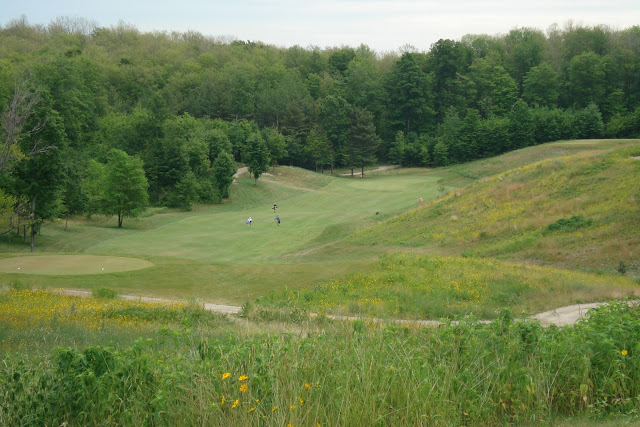The Kingsley Club is a great example of a golf course being found rather than constructed. The site has remarkable golf contours, although in some places, they are a little more severe than desired. Mike DeVries negotiated the previously clear-cut land wonderfully, taking full advantage of the macro and micro undulations, offering boldly contoured greens, heaving fairways and rugged, strategically located bunkers that combine for a thrilling round. The freely-draining soils and club policy have conspired to develop a successful maintenance regime of firm and fast conditions which further accentuates the contours of the land, amplifying both the good and bad bounces. Finally, the Kingsley Club has room to play, offering plenty of width to provide golfers with strategic decisions and encourage quicker rounds.
 |
| The simple entry into Kingsley Club. |
 |
| An inviting opening tee shot, with a big reward to those who execute and carry the central bunker complex. |
 |
| The green at No. 1 illustrates the many humps and bumps to be encountered throughout the round. |
 |
| No. 2 is a short par-three that becomes more intimidating with each round, here seen from behind, the front lobe of the green in tightly guarded by deep grass depressions right & sand and waste left. |
 |
| Sand and waste protect the left side of No. 2 green, yielding the potential for a card-wrecker early in the round. |
 |
| No. 3 provides an example of the rolling nature of the fairways at Kingsley Club. |
 |
| A healthy percentage of drives at No. 4 end-up in a depression on the right side of the fairway, leaving a blind approach into a double punchbowl green. |
 |
| This receptive punchbowl green comes at the end of the 222-yard semi-blind par three 5th. Recovery shots can use the surrounding slopes in a variety of ways to get the ball near the hole. |
 |
| The severe right-to-left slope of the fairway ay No. 6 demands players challenge the visible fairway bunkers to end up in the fairway with a clear view of the green. |
 |
| The tee at No. 7 offers plays to a severely pinched landing area. From a more forward tee, the hill encroaching into the fairway right sets up a nice diagonal carry to the hidden fairway beyond. |
 |
| The southern tee at No. 9 plays to a narrow plateau green set at a slight angle to the tee. A delicate recovery shot awaits any missed green. |
 |
| No. 10 plays through a shallow valley. |
 |
| The 11th green plays much smaller than its size, with a false right side that rejects balls easily and yields dicey chips and pitches, especially to pins located on the back shelf. |
 |
| On a course with plentiful bunkers (140 in all), No. 12 playing from a high tee into a deep valley is the only hole without sand. |
 |
| Bunkers hide the right hand portion of the 80-yard wide fairway at No. 14, steering players further left from the tee and lengthening the hole. |
 |
| No. 16 is a redan with plenty of slope and short grass right of the green to utilize in running a tee shot onto the putting surface. |
 |
| By clearing trees beyond the 15th green and creating the diagonal line of bunkers between the holes, the 16th hole merges seamlessly with the preceding hole. |








No comments:
Post a Comment